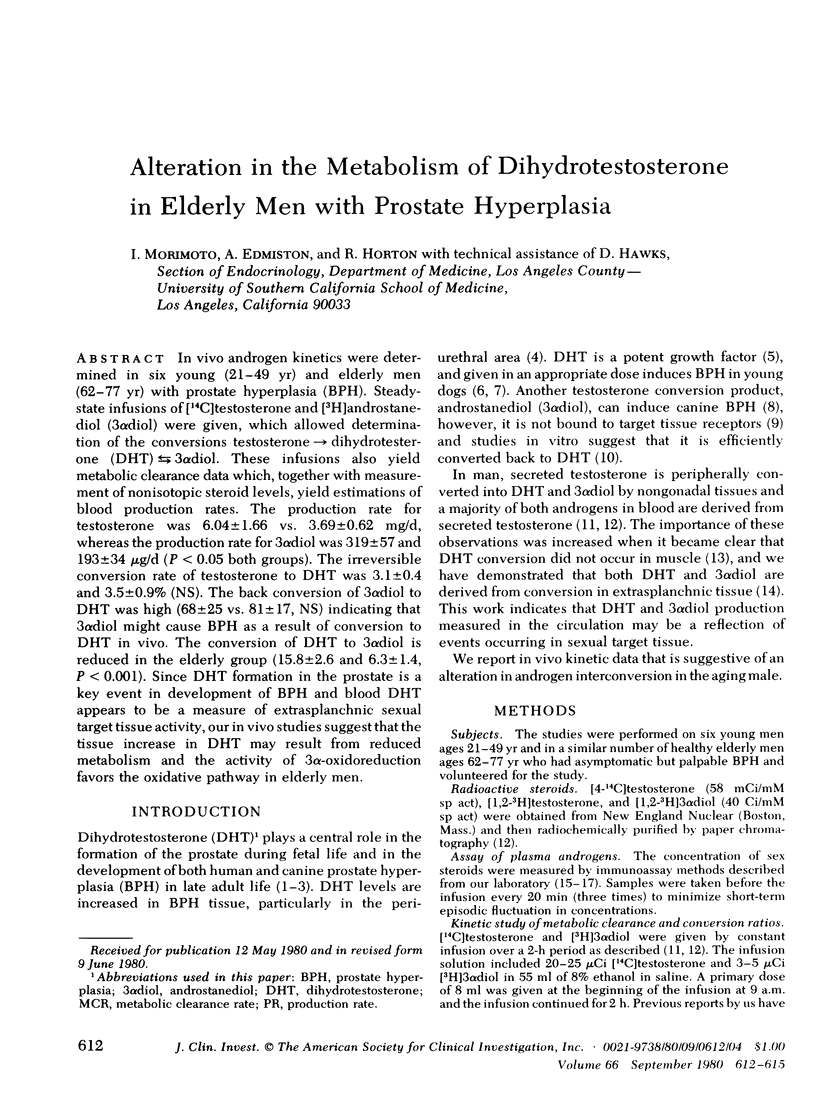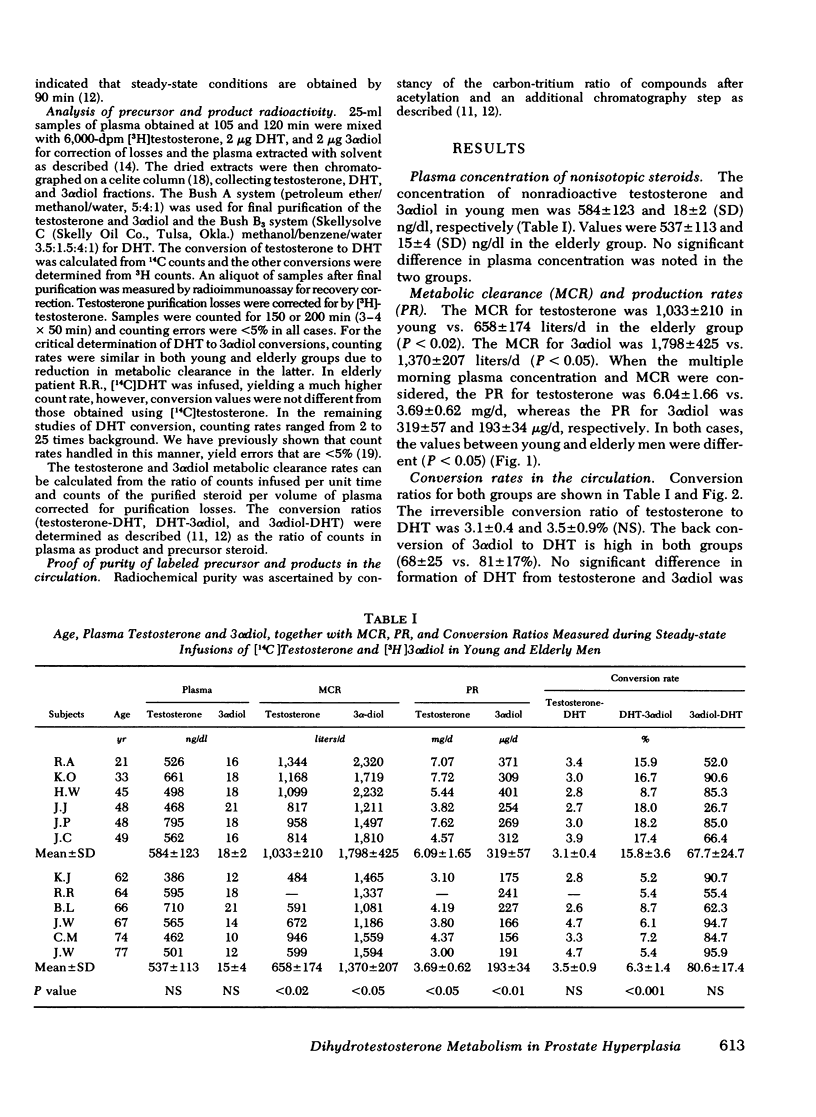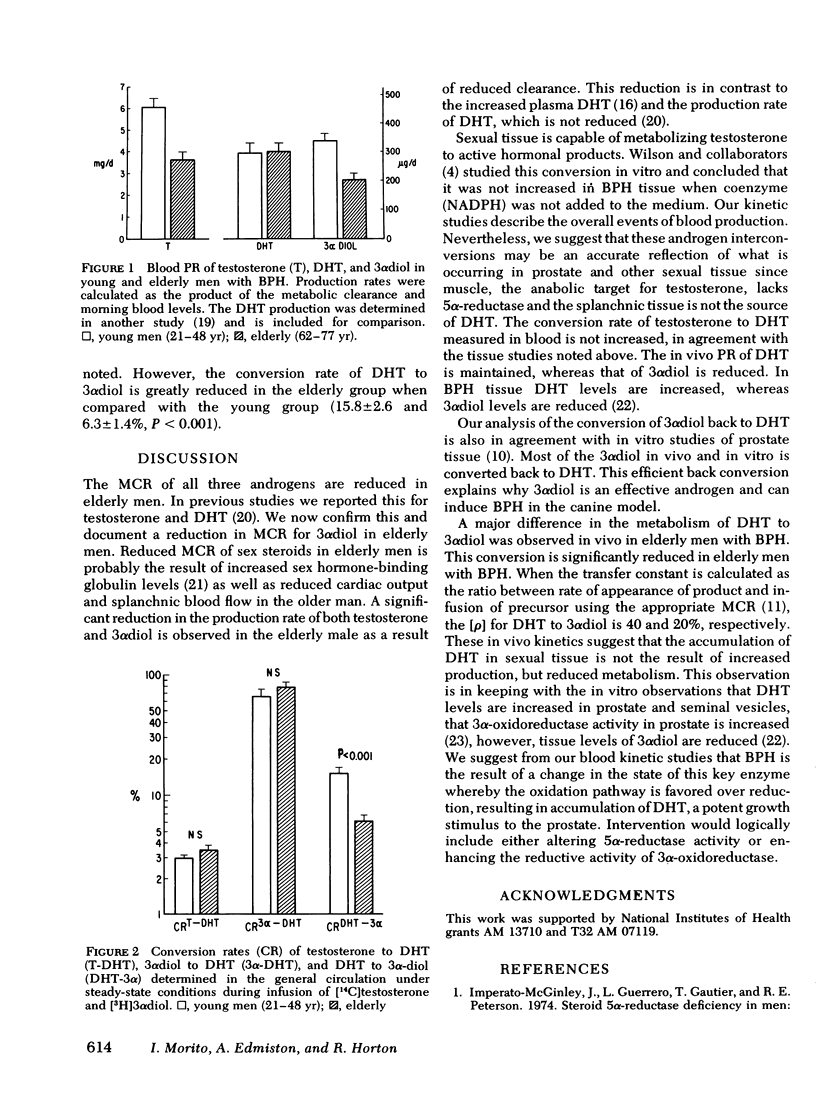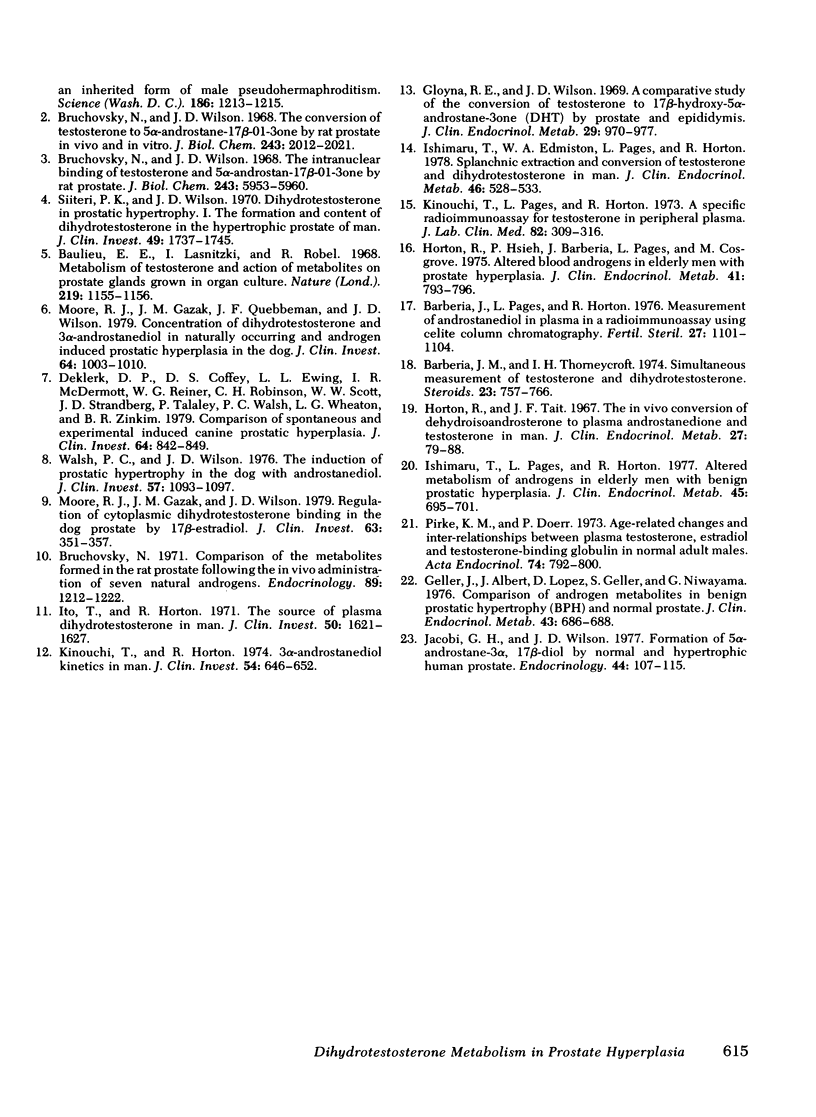Abstract
In vivo androgen kinetics were determined in six young (21--49 yr) and elderly men (62-77 yr) with prostatge hyperplasia (BPH). Steady-state infusions of [14C]testosterone and [3H]androstanediol (3 alpha diol) were given, which allowed determination of the conversions testosterone leads to dihydrotesterone (DHT) in equilibrium or formed from 3 alpha diol. These infusions also yield metabolic clearance data which, together with meaurement of nonisotopic steroid levels, yield estimations of blood production rates. The production rate for testosterone was 6.04 +/- 1.66 vs. 3.69 +/- 0.62 mg/d, whereas the production rate for 3 alpha diol was 319 +/- 57 and 193 +/- 34 micrograms/d (P < 0.05 both groups). The irreversible conversion rate of testosterone to DHT was 3.1 +/- 0.4 and 3.5 +/- 0.9% (NS). The back conversion of 3 alpha diol to dHT was high (68 +/- 25 vs. 81 +/- 17, NS) indicating that 3 alpha diol might cause BPH as a result of conversion to DHT in vivo. The conversion of DHT to 3 alpha diol is reduced in the elderly group (15.8 +/- 2.6 and 6.3 +/- 1.4, P < 0.001). Since DHT formation in the prostate is a key event in the development of BPH and blood DHT appears to be a measure of extrasplanchnic sexual target tissue activity, our in vivo studies suggest that the tissue increase in DHT may result from reduced metabolism and the activity of 3 alpha-oxidoreduction favors the oxidative pathway in elderly men.
Full text
PDF



Selected References
These references are in PubMed. This may not be the complete list of references from this article.
- Barberia J. M., Thorneycroft I. H. Simultaneous radioimmunoassay of testosterone and dihydrotestosterone. Steroids. 1974 May;23(5):757–766. doi: 10.1016/0039-128x(74)90163-9. [DOI] [PubMed] [Google Scholar]
- Barberia J., Pages L., Horton R. Measurement of androstanediol in plasma in a radioimmunoassay using celite column chromatography. Fertil Steril. 1976 Sep;27(9):1101–1104. doi: 10.1016/s0015-0282(16)42081-9. [DOI] [PubMed] [Google Scholar]
- Baulieu E. E., Lasnizki I., Robel P. Metabolism of testosterone and action of metabolites on prostate glands grown in organ culture. Nature. 1968 Sep 14;219(5159):1155–1156. doi: 10.1038/2191155a0. [DOI] [PubMed] [Google Scholar]
- Bruchovsky N. Comparison of the metabolites formed in rat prostate following the in vivo administration of seven natural androgens. Endocrinology. 1971 Nov;89(5):1212–1222. doi: 10.1210/endo-89-5-1212. [DOI] [PubMed] [Google Scholar]
- Bruchovsky N., Wilson J. D. The conversion of testosterone to 5-alpha-androstan-17-beta-ol-3-one by rat prostate in vivo and in vitro. J Biol Chem. 1968 Apr 25;243(8):2012–2021. [PubMed] [Google Scholar]
- Bruchovsky N., Wilson J. D. The intranuclear binding of testosterone and 5-alpha-androstan-17-beta-ol-3-one by rat prostate. J Biol Chem. 1968 Nov 25;243(22):5953–5960. [PubMed] [Google Scholar]
- DeKlerk D. P., Coffey D. S., Ewing L. L., McDermott I. R., Reiner W. G., Robinson C. H., Scott W. W., Strandberg J. D., Talalay P., Walsh P. C. Comparison of spontaneous and experimentally induced canine prostatic hyperplasia. J Clin Invest. 1979 Sep;64(3):842–849. doi: 10.1172/JCI109532. [DOI] [PMC free article] [PubMed] [Google Scholar]
- Geller J., Albert J., Lopez D., Geller S., Niwayama G. Comparison of androgen metabolites in benign prostatic hypertrophy (BPH) and normal prostate. J Clin Endocrinol Metab. 1976 Sep;43(3):686–688. doi: 10.1210/jcem-43-3-686. [DOI] [PubMed] [Google Scholar]
- Gloyna R. E., Wilson J. D. A comparative study of the conversion of testosterone to 17-beta-hydroxy-5-alpha-androstan-3-one (Dihydrotestosterone) by prostate and epididymis. J Clin Endocrinol Metab. 1969 Jul;29(7):970–977. doi: 10.1210/jcem-29-7-970. [DOI] [PubMed] [Google Scholar]
- Horton R., Hsieh P., Barberia J., Pages L., Cosgrove M. Altered blood androgens in elderly men with prostate hyperplasia. J Clin Endocrinol Metab. 1975 Oct;41(4):793–796. doi: 10.1210/jcem-41-4-793. [DOI] [PubMed] [Google Scholar]
- Horton R., Tait J. F. In vivo conversion of dehydroisoandrosterone to plasma androstenedione and testosterone in man. J Clin Endocrinol Metab. 1967 Jan;27(1):79–88. doi: 10.1210/jcem-27-1-79. [DOI] [PubMed] [Google Scholar]
- Ishimaru T., Edmiston W. A., Pages L., Horton R. Splanchnic extraction and conversion of testosterone and dihydrotestosterone in man. J Clin Endocrinol Metab. 1978 Apr;46(4):528–533. doi: 10.1210/jcem-46-4-528. [DOI] [PubMed] [Google Scholar]
- Ishimaru T., Pages L., Horton R. Altered metabolism of androgens in elderly men with benign prostatic hyperplasia. J Clin Endocrinol Metab. 1977 Oct;45(4):695–701. doi: 10.1210/jcem-45-4-695. [DOI] [PubMed] [Google Scholar]
- Ito T., Horton R. The source of plasma dihydrotestosterone in man. J Clin Invest. 1971 Aug;50(8):1621–1627. doi: 10.1172/JCI106650. [DOI] [PMC free article] [PubMed] [Google Scholar]
- Jacobi G. H., Wilson J. D. Formation of 5alpha-androstane-3alpha,17beta-diol by normal and hypertrophic human prostate. J Clin Endocrinol Metab. 1977 Jan;44(1):107–115. doi: 10.1210/jcem-44-1-107. [DOI] [PubMed] [Google Scholar]
- Kinouchi T., Horton R. 3Alpha-androstanediol kinetics in man. J Clin Invest. 1974 Sep;54(3):646–653. doi: 10.1172/JCI107802. [DOI] [PMC free article] [PubMed] [Google Scholar]
- Kinouchi T., Pages L., Horton R. A specific radioimmunossay for testosterone in peripheral plasma. J Lab Clin Med. 1973 Aug;82(2):309–316. [PubMed] [Google Scholar]
- Moore R. J., Gazak J. M., Quebbeman J. F., Wilson J. D. Concentration of dihydrotestosterone and 3 alpha-androstanediol in naturally occurring and androgen-induced prostatic hyperplasia in the dog. J Clin Invest. 1979 Oct;64(4):1003–1010. doi: 10.1172/JCI109536. [DOI] [PMC free article] [PubMed] [Google Scholar]
- Moore R. J., Gazak J. M., Wilson J. D. Regulation of cytoplasmic dihydrotestosterone binding in dog prostate by 17 beta-estradiol. J Clin Invest. 1979 Mar;63(3):351–357. doi: 10.1172/JCI109310. [DOI] [PMC free article] [PubMed] [Google Scholar]
- Pirke K. M., Doerr P. Age related changes and interrelationships between plasma testosterone, oestradiol and testosterone-binding globulin in normal adult males. Acta Endocrinol (Copenh) 1973 Dec;74(4):792–800. doi: 10.1530/acta.0.0740792. [DOI] [PubMed] [Google Scholar]
- Siiteri P. K., Wilson J. D. Dihydrotestosterone in prostatic hypertrophy. I. The formation and content of dihydrotestosterone in the hypertrophic prostate of man. J Clin Invest. 1970 Sep;49(9):1737–1745. doi: 10.1172/JCI106391. [DOI] [PMC free article] [PubMed] [Google Scholar]
- Walsh P. C., Wilson J. D. The induction of prostatic hypertrophy in the dog with androstanediol. J Clin Invest. 1976 Apr;57(4):1093–1097. doi: 10.1172/JCI108353. [DOI] [PMC free article] [PubMed] [Google Scholar]


